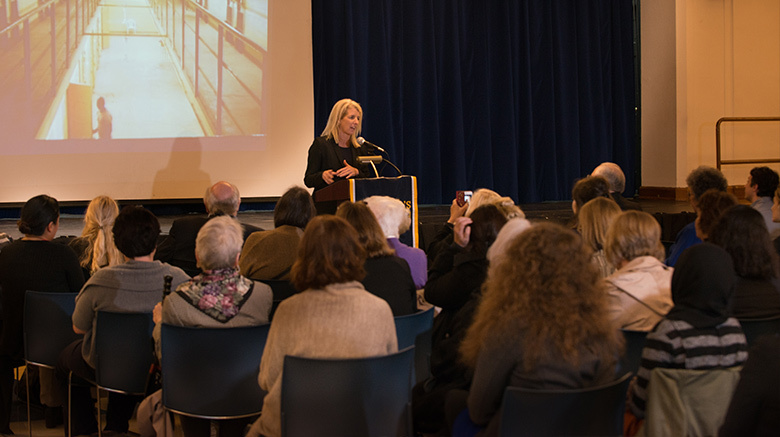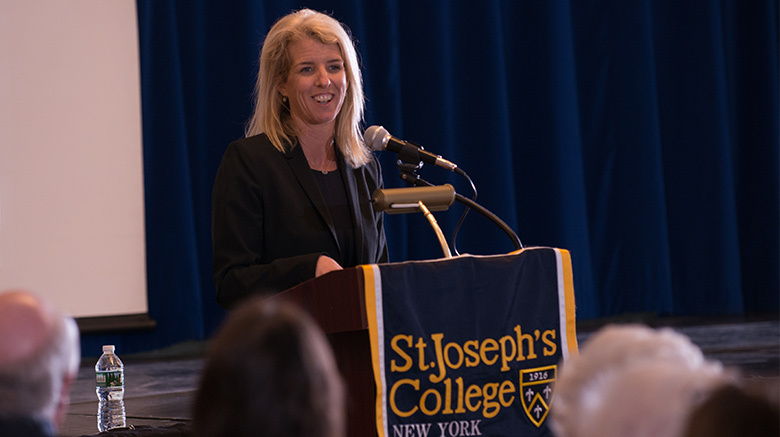There’s an almost superhuman power Rory Kennedy possesses.
In one two-minute documentary clip, the filmmaker brings a daughter’s desperation in her last stages of AIDS to a crowded auditorium at SJC Long Island. In another vignette – played for an audience at SJC Brooklyn’s Tuohy Hall – she shows a mother’s joy at being told her children can join her while she receives treatment at a substance abuse program. It’s Kennedy’s power of empathy in her work that resonates through each film she’s crafted.
An Academy Award nominated, Primetime Emmy-award winning director/producer, Kennedy presented SJC’s 2017 Presidential Lecture, “The Camera Doesn’t Lie: Social Change through Documentary Filmmaking” at both campuses, on separate days, in late April.
“It’s such a great honor for me to be at St. Joseph’s College,” Kennedy said. “First of all, it was great it was started by women! And I love your commitment to public service.”
The youngest of 11 children born to former U.S. Sen. Robert F. Kennedy and Ethel Kennedy, Rory began her foray into documentary filmmaking while finishing her senior thesis at Brown University. Kennedy’s initial subject matter dealt with substance abuse in pregnant addicts and women with children. While interviewing her subjects, she realized the potency of storytelling and the positive change it could influence in communities and in government.
I can’t bring everyone to Washington, but I can bring a camera to their living rooms and document their stories.” – Rory Kennedy
“I wanted them to tell their stories to our legislatures and policy makers,” Kennedy said, referencing the catalyst of her first documentary, Substance. The 1994 film — a portrait of the legal, moral and health care battles waged to improve treatment for female addicts — revealed the problems of the early ’90s health care crisis to the world.

Rory Kennedy presented the 2017 Presidential Lecture at SJC Brooklyn on April 25, and SJC Long Island April 26.
That mission to uncover tragedy to influence positive social change is the underlying mission of Kennedy’s work.
“I want to help people understand the nuance and realities of what is going on,” Kennedy said. “What these peoples’ lives are like and choices they were trying to make, and the lack of support we were giving them as a society.
“I can’t bring everyone to Washington, but I can bring a camera to their living rooms and document their stories.”
The power of presenting firsthand the realities facing the global AIDS crisis and victims of civil injustice has made a remarkable difference. Kennedy’s films have resulted in policy changes, boosts in federal program funding and most importantly, bringing the humanity of society to a widespread audience.
Each time a man stands up for an ideal or acts to improve the lot of others or strikes out against injustice, he sends forth a tiny ripple of hope.” – Robert Kennedy
“Ultimately that’s the power of film,” Kennedy said. “It’s having this connection with these individuals, who you would never be exposed to, and never necessarily care about. Sharing these stories and having people understand that for every story they’re seeing, that represents millions of people.”
When asked during a question and answer period what she would want to work on next, if she had unlimited budget and access to make any film she desired, Kennedy was quick to respond. “Honestly, I personally am very invested in what’s happening right now with this administration,” Kennedy said, “so i would probably invest in something that could change the course of the president’s tenure.”
Ultimately, having that purpose in life, to give back to others, is Kennedy’s greatest contribution, she said, noting that she appreciated the efforts of St. Joseph’s College and its mission to reciprocate that same passion.
“I want to end with a quote my father said when he was in South Africa in 1966,” Kennedy said, quoting Robert Kennedy:
“Each time a man stands up for an ideal or acts to improve the lot of others or strikes out against injustice, he sends forth a tiny ripple of hope. And crossing each other from a million different centers of energy therein, these ripples create a current that can wipe down the mightiest walls of oppression and resistance.”

